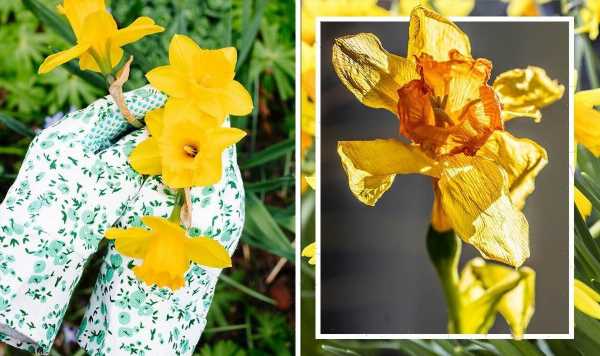Alan Titchmarsh shares tips for caring for daffodils
We use your sign-up to provide content in ways you’ve consented to and to improve our understanding of you. This may include adverts from us and 3rd parties based on our understanding. You can unsubscribe at any time. More info
Daffodils are loved for their striking yellow flower heads but they can look disappointing when the bright clusters of petals begin to fade away. Aftercare is crucial to secure a fresh flush of blooms the following spring, but what should you be doing to look after your garden daffodils after they finish flowering? These are the five steps to take once your spring bulbs reach the end of their season.
How to care for daffodils after flowering
Daffodils bloom for anywhere between six and 10 weeks depending on where you live in the UK.
While most plants can be left alone after their flowering season is over, perennial spring bulbs require specific care to keep them healthy – but where should you begin?
Deadhead as soon as possible
Deadheading is crucial to allow space for fresh flowers to grow, and it should be the first thing you do once daffodils begin to wilt.


Faded blooms can be picked away using your finger and thumb, just use a light pinching motion to remove the unsightly growth.
When you go to deadhead your daffodils, it is important that you pull both the papery flower and the conjoining stem.
The main goal of deadheading is to stop new seeds forming, allowing the plants to put all their energy back into the bulb for a good flowering display the following year.
Deadheading also keeps the display looking its best, so you can make the most of the healthy growth while it lasts.

Allow the leaves to die back naturally
Though the green leaves are not the main attraction of vibrant yellow daffodils, you should avoid removing any of this growth until a few weeks after the plant has finished flowering.
Leaving the foliage alone is crucial to allow photosynthesis to continue, which will ultimately help your plant return the following season.
You will know when it’s time to cut back daffodil foliage as the vibrant green leaves will fade to varying shades of yellow.
According to the Royal Horticultural Society, this usually takes around six weeks to happen after the flowers are gone.
DON’T MISS:
Gardening tips: ‘Quickest’ way to remove moss from pavements – how to [ANALYSIS]
Gardening: 7 jobs to do right now for a thriving spring garden [REVEAL]
How and when to deadhead flowers – ‘we need to do it’ [INSIGHT]

Tie and feed your daffodils
To help the foliage die down more quickly, you can tie daffodil leaves into a knot after the plant has finished flowering.
This will speed up the natural process which turns the leaves from green to yellow while keeping your flowerbed looking neat and tidy.
Your plants should also be fed at this stage according to The Daffodil Society.
The Society said: “After flowering keep bulbs watered and feed once a week with a high potash fertiliser until the leaves die back.”

Use sulphate of potash on pot-grown daffodils
Caring for your daffodils after flowering is crucial if you want to enjoy a fresh flush of blooms each year, but there are a few things you should do differently when dealing with pot-grown plants.
The Daffodil Society said: “Watering and continuation of feeding is still vital with the aim of having a firm and ripe bulb when all growth is completed.”
To keep your spring bulbs in good condition beyond the growing season, the society recommended administering two feeds of sulphate of potash after the plant has flowered.
Dissolve one teaspoon of this fertilising compound into a gallon of water, pouring around half a pint of the liquid into each pot.
Once the pots have been fed, place them in a shady spot to protect them from heat damage in the warmer months.
Cut back yellow foliage
Once the colour change has taken place, it is time to brush off your secateurs and cut back your spring daffodils.
According to gardening expert, Rachel Crow, it’s important to leave daffodils to die down naturally to put energy back into the bulb to help the plant produce flowers the following spring.
Doing this too early could leave your flower bed completely empty, with no vibrant yellow blooms to enjoy next year.
Source: Read Full Article
